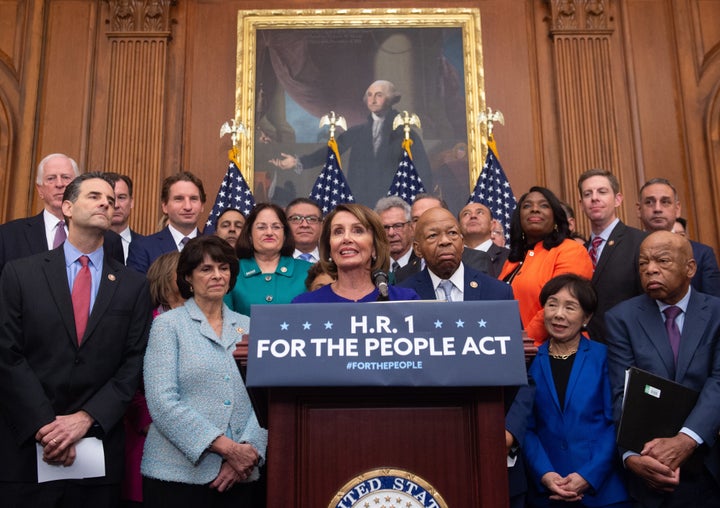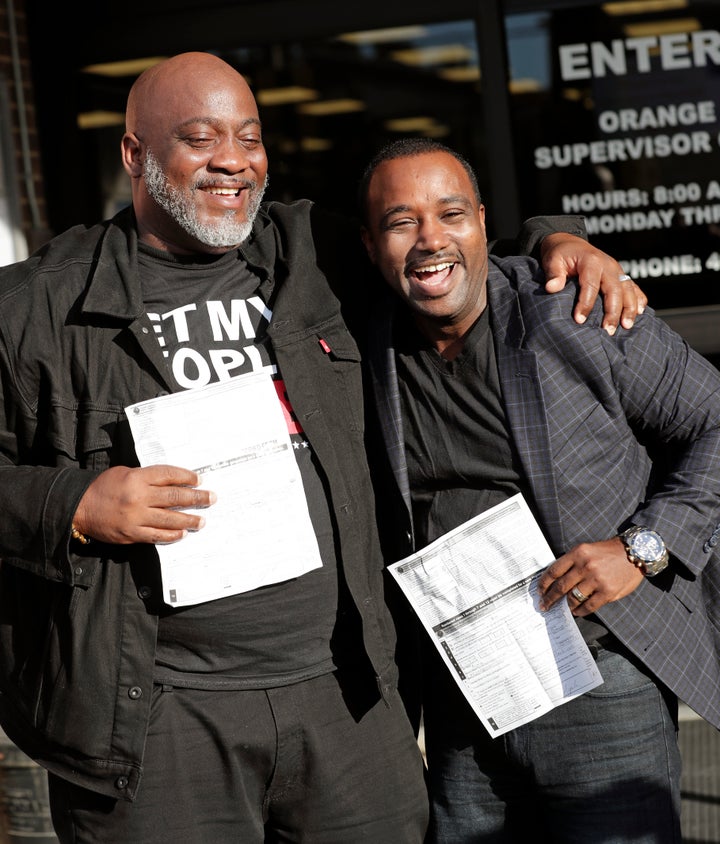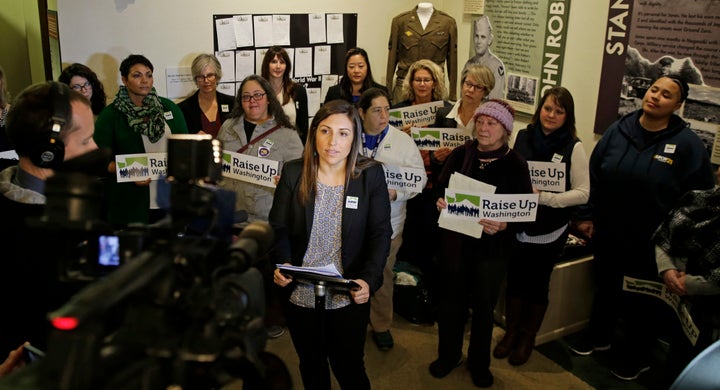A sweeping reform bill that House Democrats say will be their first priority after ending the partial government shutdown is filled with policies that would fundamentally alter the nation’s voting and campaign finance systems. These policies are not coming out of nowhere. Most of them have been implemented and tested in cities and states across the country.
“Within the last five or six years, you just got more and more of these solutions happening at the state and local level,” said Rep. John Sarbanes (D-Md.), the bill’s chief sponsor. “It’s not a unicorn. It’s not like we’re talking about something that exists in the atmosphere of Jupiter. This is happening in America.”
Supreme Court Justice Louis Brandeis, in a famous dissenting opinion from 1932, asserted the freedom of a state or local government to “serve as a laboratory; and try novel social and economic experiments without risk to the rest of the country.” This “laboratories of democracy” concept holds that state and local governments are the proper place to test policies before they move to the national stage.
That is exactly what has happened with the sweeping policies in Democrats’ H.R. 1, which they’re calling the For the People Act. The bill’s campaign finance provisions on public election financing, dark money disclosure and democracy vouchers have all been field tested. The same is true of automatic voter registration, felon re-enfranchisement and the use of independent, nonpartisan redistricting commissions.

Automatic Voter Registration
Since 2015, 15 states and the District of Columbia have adopted automatic voter registration, a popular reform among advocates who believe it can significantly expand the number of people on the voting rolls in the United States.
The policy works slightly differently in each state, but the basic premise is the same: When someone interacts with the state motor vehicle or other agencies, they are automatically registered to vote unless they opt out. If they are already registered, their information gets updated if needed. Federal law already requires state motor vehicle and some state agencies to offer people the opportunity to register to vote, and automatic voter registration essentially tweaks the process to make registering an opt-out choice instead of an opt-in.
Oregon, considered the model for automatic voter registration, was the first state in the country to pass it in 2015. While it’s still relatively early to assess the impact, the early evidence is encouraging. The policy went into effect in January 2016 and in a little over a year and a half, the policy added 375,000 people to the voter rolls. A 2017 analysis from the left-leaning Center for American Progress found over 116,000 people had been added to the rolls who wouldn’t have otherwise registered.
Automatic voter registration also went into effect in California last year, where it added 727,924 new voters to the rolls since its launch in April and updated the addresses of 269,365 people. (There were around 5.5 million eligible but unregistered voters in the state as of October.) The program also attracted scrutiny when it emerged the DMV made errors on thousands of voter registrations, including registering people who were ineligible to vote. The head of the DMV resigned and the agency imposed an additional level of review on the voter registrations it received.
Automatic Restoration Of Voting Rights For People With Felony Convictions

Forty-eight states don’t allow people with felony convictions to vote while they are incarcerated, but states have widely different policies on when and how ex-felons can get back their right to vote. Some states allow former felons to vote once they’re released from prison, while others bar them while they’re on probation or parole. The various policies can be extremely confusing and deter people from registering to vote, even if they’re eligible.
The For the People Act aims to fix this problem by automatically restoring voting rights once someone is released from prison. Currently, 13 states and the District of Columbia do this, but having a federal statute would help make the process easier for everyone involved.
“I think having a uniform rule that applies to everyone, everywhere and making that loud and having some action on it would be really helpful,” said Sean Morales-Doyle, counsel at the Brennan Center for Justice, a New York-based nonprofit advocating for campaign finance reform and voting rights. “Having a uniform policy would clear up confusion among voters. It would also clear up confusion among elections officials. It would make keeping track of voter lists a lot easier.”
Dark Money Disclosure
The Supreme Court’s 2010 Citizens United decision led to an explosion of undisclosed money spent by nonprofits, trade associations and corporate entities in elections. Congress attempted to fix the court’s collateral damage to transparency with the Disclose Act in 2010, but it fell one vote short of clearing a Republican filibuster in the Senate.
States have since stepped in to pass their own Disclose Acts or to issue regulations to stop dark money in state elections. Varying disclosure rules to plug the holes created by the Supreme Court have been adopted in California, Delaware, Montana, New York, Texas, Vermont and Washington. Some of these laws provide more disclosure than others, and that can help Congress determine the best option for federal elections.
“California’s Disclose Act is great but limited,” said former Federal Election Commission Chairwoman Ann Ravel, now with the pro-disclosure nonprofit MapLight.
The California government has enacted two disclosure bills since the Citizens United decision. The first was passed in 2014 to require any group spending more than $50,000 on elections to disclose its donors. The second, enacted in 2017, mostly focuses on requiring independent spenders to post disclaimers detailing their top three donors on their advertising and campaign materials. Ravel believes that the $50,000 threshold for disclosure could be lower ― which is something the House Democrats’ bill does.
Democracy Vouchers

A little-noticed provision in Democrats’ big reform bill would create a pilot program for “democracy vouchers” ― a proposal to provide every citizen with vouchers that can be used as small-dollar political donations. These vouchers would come in $25 increments, but could be used to give donations as low as $1.
The “democracy vouchers” idea was first proposed by constitutional law professor Bruce Ackerman decades ago, but had never been adopted until Seattle voters backed a 2015 initiative to implement the idea. The program has already enabled a large number of people who would otherwise be incapable of affording political donations, including homeless people, to participate in the political process by contributing to candidates. One study found that 84 percent of people who used used their vouchers in the city’s 2017 elections had not made a political contribution in at least the previous two election cycles.
The vouchers also provide an alternative fundraising system for candidates who lack the kind of connections to big-money donors that are often seen as necessary to run for office.
In 2017, Seattle City Council candidate Teresa Mosqueda became the first person in the country to win their first election running with democracy vouchers. She had kept hearing that she should run for City Council from participants in a program she ran for the AFL-CIO that encouraged women, people of color and working-class people to run for office. She was the kind of person she was trying to get to run: a Latina in the labor movement who didn’t come from money. But her background also presented an obstacle to funding a campaign ― until Seattle’s democracy vouchers became available.
“The democracy vouchers program really took the pressure away from having to see yourself bankrolling a campaign or frankly having to dial for dollars for the majority of your time,” Mosqueda said.
“I was able to spend more time talking with people about what they wanted to see in government,” she added.
The pilot program in the Democrats’ bill would be implemented in three randomly selected states to test how it works for congressional elections and whether it should be expanded to the whole country.
Early Voting And Same-Day Registration
The For the People Act would require states to allow people to register on the same day they vote and to allow voters to cast ballots for at least 15 consecutive days before Election Day. It would require poll sites to be open at least four hours each of those days and, to the greatest extent possible, that they be located near public transportation.
Twenty states and the District of Columbia have approved some form of same-day registration. It’s seen as a reform that can greatly drive up voter participation rates because people start paying more attention to an election the closer it gets. Federal law currently lets states cut off voter registration 30 days before an election. Activists also embrace early voting because it gives people more time to go to the polls at their convenience.
Early voting in particular has been at the center of many recent fights between Republicans and Democrats over voting laws. The conventional wisdom is that early voting benefits Democrats, so Republicans in several states have moved to limit its availability. But one 2017 paper published by four political scientists at the University of Wisconsin-Madison suggests that reality may be more complicated. The authors analyzed early voting in the 2004, 2008 and 2012 presidential elections and found that while Election Day registration tends to benefit Democrats, early voting on its own is more likely to benefit Republicans.
“The type of voter who takes advantage of early voting ― older, whiter, and wealthier ― is already likely to vote, and more likely to vote Republican,” the authors wrote in a blog post last year. “Our findings confirm that early voting on its own has a negative and statistically significant effect on Democratic vote share in all three presidential elections we analyzed. The availability of early voting in isolation raises the Republican vote by about six percentage points.”
When same-day registration is combined with early voting, the paper found, voter turnout aligns more with the conventional wisdom.
Independent Redistricting Commissions
H.R. 1 would require states to create independent commissions that would be responsible for drawing congressional districts. State lawmakers currently have the power to draw districts once a decade, and both parties have manipulated that process to their advantage. In 2011, Republicans saw an opportunity to take control of state legislatures, control the redistricting process and lock in an electoral advantage for the next decade. They executed that plan extremely precisely and well.
Six states ― Alaska, Arizona, California, Idaho, Montana and Washington ― use independent redistricting commissions to draw lines for state or congressional districts. (Voters in Michigan, Utah and Colorado passed ballot measures establishing independent commissions in the November election.) Advocates say lawmakers have firm incentives to draw districts that favor their parties, and the independent commissions offer a firm check to make sure districts are fair.
“When lawmakers draw their own lines, they lose all of their philosophical ideals and they become ugly monsters.”
- Kathay Feng, national redistricting director at Common Cause
In 2011, California’s independent redistricting commission drew electoral boundaries for the state for the first time. Anyone can apply to serve on the 14-member commission ― which is made up of five Democrats, five Republicans and four people not affiliated with either party ― but there are strict requirements on who can serve. Eligible applicants must be registered to vote in California and have voted in two of the last three elections. In the 10 years leading up to submitting their application, they also can’t have run for office, worked for a lawmaker, political party or as a lobbyist, or donated $2,000 or more to a party or candidate. Votes from multiple Democrats, Republicans and independents are required to approve a plan. H.R. 1 would impose similar safeguards on the independent commissions it creates to help ensure the districts are fair.
“When lawmakers draw their own lines, they lose all of their philosophical ideals and they become ugly monsters that are willing to cut out competitors, punish people from the other party and try to draw the most protective district for themselves so they don’t have to face serious competition for the next 10 years,” said Kathay Feng, national redistricting director at the good government group Common Cause, which championed the creation of California’s commission.
Small-Donor Public Financing
The For the People Act’s main campaign finance reform is the creation of a small-donor matching system to publicly finance congressional elections. It is based on the decades-old public financing program run for New York City elections.
New York adopted a small-donor matching system to publicly finance its elections in 1988 in response to a series of corruption scandals throughout city government. At the time, the system provided a 1-to-1 match for donations of $1,000 or less. A candidate received $1 in public funds for every $1 of a contribution up to $1,000. But the system has changed to boost the power of small donors over the years.
Proponents of New York City’s matching fund system point to changes that greatly enhanced the role of small donors as the public match was increased and the contribution limit for matching funds was lowered. Currently, the system provides an 8-to-1 match for contributions up to $175. That means a $175 contribution actually counts as a $1,575 contribution after the public funds are added in. Democrats’ For the People Act uses a 6-to-1 match, a rate used by the New York City system from 2009 through 2018, for contributions up to $200.
“The fact that it’s been around for 30 years and it’s still working, I think that’s pretty remarkable,” said Lawrence Norden, a lawyer for the Brennan Center for Justice.
New York City’s system has enabled candidates ― especially those from less affluent neighborhoods ― to more consistently rely on small donors in their districts. “The city’s public financing system gives candidates an incentive to reach out to a broader and more diverse array of constituents to fund their campaigns,” a 2012 study by the Brennan Center and the progressive think tank Demos found.
This small-donor matching system has also spread to other states, cities and municipalities. Some matching funds programs have existed for years, but in the past five years, adoption has spread rapidly to Washington, D.C.; Montgomery and Howard counties in Maryland; and Suffolk County, New York, among other places. New York state lawmakers are currently debating the statewide adoption of such a program.
“If New York City is any guide, it actually changes how candidates raise money,” Norden said. “So, right now you have many candidates raising many more contributions than we’ve seen in the past raising from small donors. I think we would see even more of a change of going to constituents and small donors as a source of funding rather than the biggest donors.”
CORRECTION: A previous version of this story stated that Teresa Mosqueda was the first candidate in the country to run and win using democracy vouchers. She is the first first-time candidate to win.